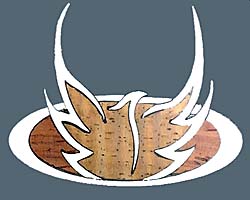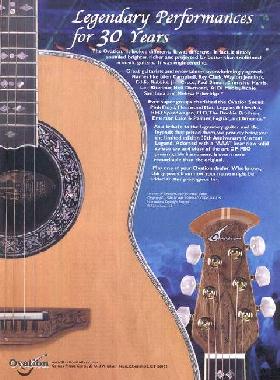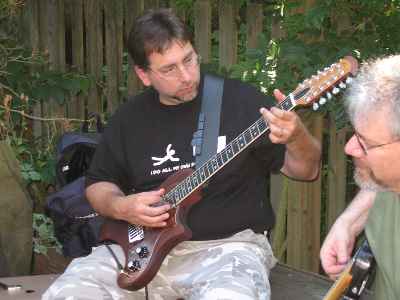|
|

Joined:
June 2002
Posts: 6197
Location: Phoenix AZ | Sitka, Englesman, Adirondak ??? How much of a difference. Are their "rules of thumb" ? or is every tree different no matter what the heck you call it. | |
| | |

Joined:
September 2003
Posts: 9301
Location: south east Michigan | The thread about "acoustic cables" comes to mind. | |
| | |
Joined:
July 2003
Posts: 181
Location: North Carolina | Check out this link for a discussion of the 3 kinds of spruce:
http://www.bourgeoisguitars.com/tapping_tonewoods.htm
Franklin | |
| | |
Joined:
November 2002
Posts: 3611
Location: Pacific Northwest Inland Empire | Kinda like the difference between Celebrex & Vioxx- if it doesn't put you into cardiac arrest.
Seriously, though, there are structural density issues between the species, and they have subtle sonic & durability attributes. I believe Englemann & Adirondack are generally harder & tighter-grained. Consult The Guild of American Lutherie on this issue. | |
| | |
Joined:
January 2005
Posts: 640
Location: boulder | morning all,
Short answer, they probably have general tendicies, while each tree is slightly different.
long answer before coffee kicks in...
and knowing nothing about anything really, (which never stopped me yet).
Isn't part of woods tone derived from it's density? And IF Density in wood comes from molecular composition and water content, then, Different trees from even slightly different climates might have different water content and density inside. A well nourished tree might be more stout, hence more dense. A tree that is stretching for sunlight or is lacking in water, might grow taller, thinner and be less dense.
Then of course you have the drying out process. And where were the tree harvested? was there alot of pollution in the air?
I read The old stradivarios (sorry about spelling) violins sound so good because the wood they used was soaked in the river near the "factory" (ok , it was a shop probably). Chemicals in the water may have "treated" the wood somehow. (Or it was that their wood was really old to begin with).
So my final answer is, I don't know about rules of thumb as to how each spruce performs. But wood is a living thing. It's affected by its surroundings. I would think that Ovation would have tested the tonal qualities of different woods, as well as different types of spruce woods. CWK commented that the birch sounded best in the adamas. So they did try to some degree to find out.
Dave , what the's the question??? need coffee-need more feinne. peace mike | |
| | |
Joined:
January 2005
Posts: 640
Location: boulder | Franklin,
wow, thanks that was an excellent article. super informative.
Dave,
Yeah, Franklins article is what I was trying to say. :) ;) | |
| | |
Joined:
November 2002
Posts: 3611
Location: Pacific Northwest Inland Empire | This is another good source. This guy's business, and his links, are very educational. Plus, you can surf to construction projects, showing you how the technical stuff is translated to the "real" world. Mr Cumpiano is regarded as one of the best luthiers, and teachers, around.
http://cgi.ebay.com/ws/eBayISAPI.dll?ViewItem&category=2385&item=3778193776&rd=1&ssPageName=WDVW | |
| | |

Joined:
August 2003
Posts: 4619
Location: SoCal | To me, every tree or cut from the tree is different and each "type/family" of tree.
So, we look at aesthetics, other materials used in construction of guitar, and what market (style of play, cost basis, etc.)
Years ago, before internal amplification, large body spruce gave us the best projection. As pre-amps were developed, it wasn't as necessary to have volume projection from the instrument. This is where we now see other woods from the spruce family being used. Now, if you want to play "softly", turn up the volume.
Then, depends on the standards by the manufacturer...this is where the difference between each cut is important. We see
"AA", "AAA", and "Master Grade"...this is a subjective evaluation and differs in quality and term by each manufacturer. At least within the single manufacturer (i.e., Ovation), in addition to the type of spruce, we do see differences between an "AA" and "AAA". IMHO, I believe there is a difference in "voice" between the prior Custom Legends (AAA) and the 30th Anniv CL - AAA bearclaw spruce, bone nut, etc.
In the past, we saw the same bowl (other than very early Adamas) used for each model. Now, we have the new contoured bowl. It is more than just a new shape. My understanding of the new bowl is that it gives the engineering department the ability to "tune" the bowl for upcoming models for the intended audience. Thus, they can vary not only the top, bridge and nut material, but the bowl.
For me, this is positive. Unlike some manufacturers, we can't necessarily go to our local guitar stores and play several Ovation guitars of the same model before we buy. Would be nice to have four or five to pick our personal choice. I have bought Custom Legends from 1979 to the 2004 30th Anniv and have found a consistent quality in "voice" and playability. Of the four 30th Anniv CL's that I bought, all were great. When I was able to compare two or more of the same model, other than ageing of the top, I found the same consistency (i.e., 1537, CA, 1127) | |
| | |

Joined:
December 2003
Posts: 13987
Location: Upper Left USA | Let me add this bit to the mix. About 30 or so years ago someone in my neighborhood took a vacation to Northern California and thought the Redwoods were, like, totally awesome (they are!). Said person brought home about a dozen saplings that were out for impressed tourists to buy, much like the little Alligators they sell in Florida.
Said Tourist plants several in his 80'x100' yard and offers a couple to the neighbors! Now here in Western Worshington the water is plentiful and the temperature is, well, temperate. In Upper Cal there is less water and I believe the Redwoods are growing in a higher elevation.
The Northern Cal Redwoods grow slower, usually adding 30-60 annular rings (years) per inch. They fight infection by making an oil that permeates the wood and bark. The Western Wash grown Redwoods, which are still Cedars grew at 3-6 annular rings per inch and were susceptable to bugs that it didn't know about.
Helpful hint #37 - Don't plant Redwoods 8' from your foundation!
I helped my neighbor remove some of this wood from his yard. It isn't very good firewood either.
So when you select a wood type consider the location of the growth. Also consider if it was a denser old growth or a newer growth. The Sitka Spruce and Fir varieties from the mountains around here are tall, straight and dense because of the ever changing climate - they may become more and more scarce!
And wood, like people developes it's character by the trials it has endured! | |
| | |

Joined:
April 2004
Posts: 13303
Location: Latitude 39.56819, Longitude -105.080066 | Ahhh Tony,
If only they had an abalone tree for you :D
Stephen | |
| | |

Joined:
August 2003
Posts: 4619
Location: SoCal | ;) :p ;) :p
even my 1st Adamas had abalone...the Millennium I got from Woz
;) :p ;) :p | |
| | |

Joined:
December 2003
Posts: 13987
Location: Upper Left USA | That's right. Not all the good stuff grows on trees. Some of it comes from scum sucking bottom dwellers!
It is amazing where we get some of our "ornementation". | |
| |
|
 Spruce is Spruce is Spruce ...
Spruce is Spruce is Spruce ... Spruce is Spruce is Spruce ...
Spruce is Spruce is Spruce ...